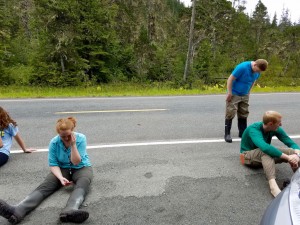Somewhere, something incredible is waiting to be known
– Carl Sagan
By: Cecilia and Sara
Laughter resounded from the CAUSE students as our instructor Joe Bishop stumbled in the Cowee waters and was soon submerged up to his chest. Denice and Alyssa, galvanized to save Joe, made the slow trek to move ten meters to rescue him. Joe was not the only person to fall victim to the wetland. In fact, only Amanda left the field site without a boot filled with water.
The site was selected along our hike on the Point Bridget trail; it was appropriate for our studies because it fit the definition of a poor fen
Caption: CAUSE students collecting data, taken from a safe, dry distance
There are three wetland types we are studying in Alaska: rich fens, poor fens, and bogs. These are differentiated from each other by vegetation and hydrology. Rich fens are open systems (water flowing in and out) and are relatively nutrient poor. This is seen in the nearly entirely sphagnum moss vegetation. Rich fens are also open systems but have more nutrients, evidenced by the presence of longer grass. Bogs are defined as being entirely closed off hydrologic systems.
We re-emerged onto the trail sopping wet and began emptying our filled rubber boots. Denice, with a cluster of self-identified wetland plants in her arms, congratulated us for becoming true wetland scientists.
Caption: Sara, Andrew, and Andy one field day richer in experience
After learning how to identify wetland hemlocks, we departed our first field site with the beginning of our Alaskan data.


